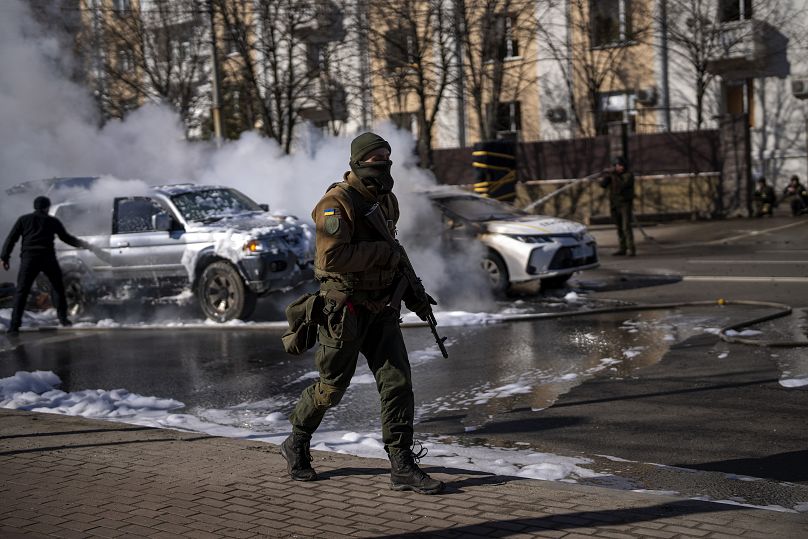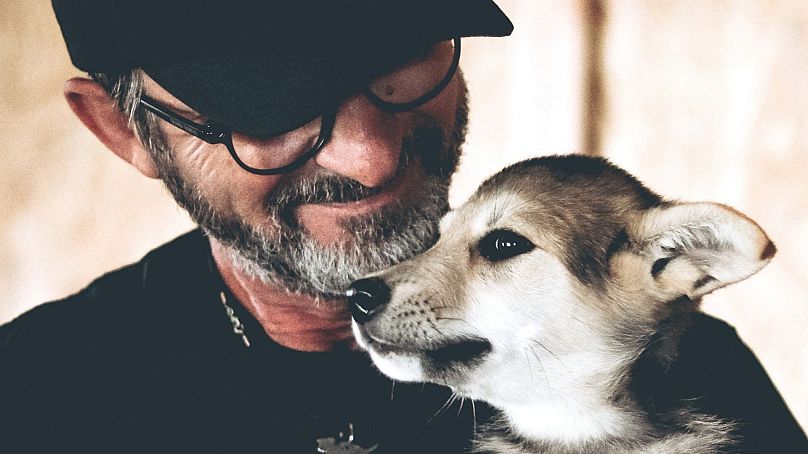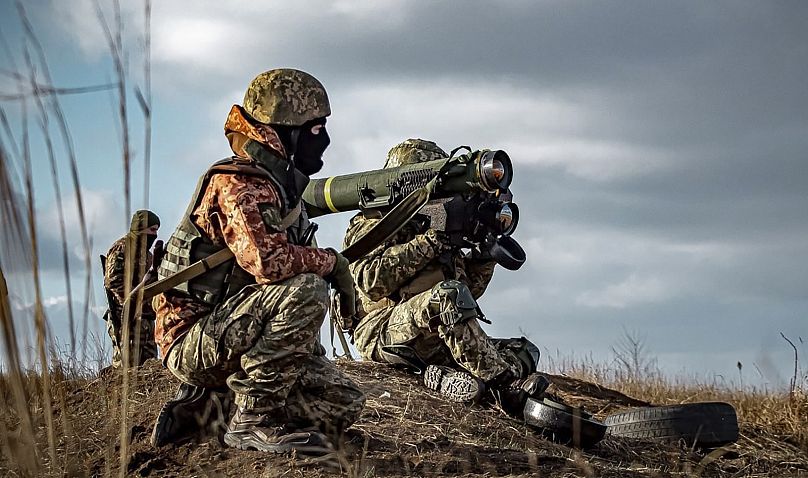
Ukraine has waived visa requirements for foreigners entering
the nation in order to help fight against the Russian military -
Copyright AP Photo
By Ben Anthony Horton with AP • Updated: 01/03/2022 - 19:06
British volunteers eager to fight against Vladimir Putin's forces are heading to the Ukrainian embassy in London to enlist - despite warnings from ministers that they could be breaking the law if they do so.
Groups of men were seen speaking with Ukranian officials outside the embassy in west London, after answering Ukraine's call to arms for foreign fighters wishing to join the country's defence.
Among them was gym owner Leon Dawson, who said he was prepared to lose his life fighting in the country's newly formed International Legion.
We can help, so why not?
"They look like they need help,” says Dawson. “We're young, strong, fit men. We can help, so why not?"
As well as young men, 60-year-old Brian Grove was among the Brits hoping to travel to Ukraine.
The former Territorial Army member from Kent says he is “ready to get on a flight tomorrow” if permitted.
“I'm 60, which means I'm just about within the age range they will accept,” jokes Grove.
Can British citizens travel to Ukraine to fight?
By Ben Anthony Horton with AP • Updated: 01/03/2022 - 19:06
British volunteers eager to fight against Vladimir Putin's forces are heading to the Ukrainian embassy in London to enlist - despite warnings from ministers that they could be breaking the law if they do so.
Groups of men were seen speaking with Ukranian officials outside the embassy in west London, after answering Ukraine's call to arms for foreign fighters wishing to join the country's defence.
Among them was gym owner Leon Dawson, who said he was prepared to lose his life fighting in the country's newly formed International Legion.
We can help, so why not?
"They look like they need help,” says Dawson. “We're young, strong, fit men. We can help, so why not?"
As well as young men, 60-year-old Brian Grove was among the Brits hoping to travel to Ukraine.
The former Territorial Army member from Kent says he is “ready to get on a flight tomorrow” if permitted.
“I'm 60, which means I'm just about within the age range they will accept,” jokes Grove.
Can British citizens travel to Ukraine to fight?
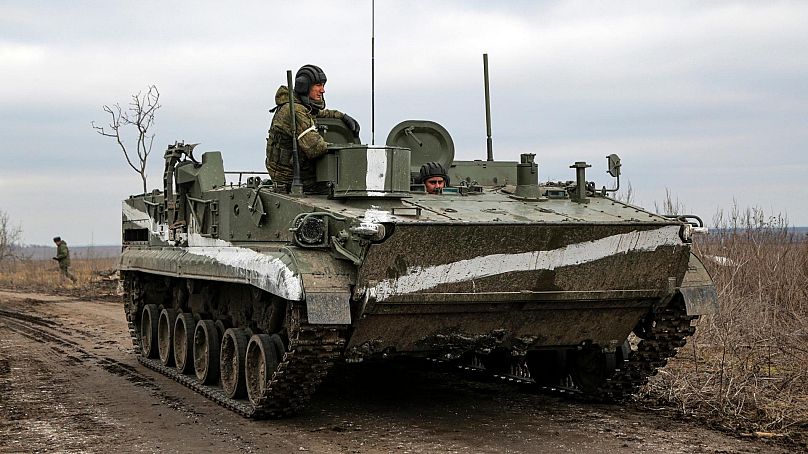
An armoured vehicle rolls outside Mykolaivka, Donetsk region, Ukraine
AP Photo
It is still unclear whether foreign nationals will be legally allowed to represent the Armed Forces of Ukraine in the current conflict.
Warnings from UK Defence Secretary Ben Wallace urged Brits against joining the fighting, suggesting there were better ways to assist Ukraine - including volunteering to support refugees, or donating to the Ukrainian embassy.
But while Wallance remained resistant to the idea, Foreign Secretary Liz Truss said she “wouldn’t oppose” British nationals travelling to the country to fight the Russian invasion.
For those determined to go, Ukraine has waived visa requirements for foreigners entering the nation in order to help fight against the Russian military.
In a decree signed on Monday, Ukrainian President Volodymyr Zelenskyy authorised a ‘temporary visa-free regime’ for foreigners who want to aid the country's defence, effective immediately.
Citizens of the United States and European Union had previously required visas for tourist visits of more than 90 days within a six-month period.
It is still unclear whether foreign nationals will be legally allowed to represent the Armed Forces of Ukraine in the current conflict.
Warnings from UK Defence Secretary Ben Wallace urged Brits against joining the fighting, suggesting there were better ways to assist Ukraine - including volunteering to support refugees, or donating to the Ukrainian embassy.
But while Wallance remained resistant to the idea, Foreign Secretary Liz Truss said she “wouldn’t oppose” British nationals travelling to the country to fight the Russian invasion.
For those determined to go, Ukraine has waived visa requirements for foreigners entering the nation in order to help fight against the Russian military.
In a decree signed on Monday, Ukrainian President Volodymyr Zelenskyy authorised a ‘temporary visa-free regime’ for foreigners who want to aid the country's defence, effective immediately.
Citizens of the United States and European Union had previously required visas for tourist visits of more than 90 days within a six-month period.
The risk versus the reward
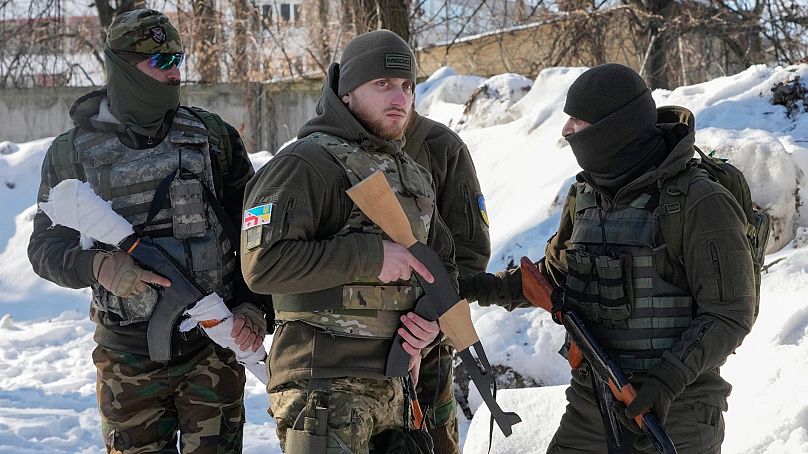
Soldiers train for combat in UkraineAP Photo
On day six of the Russian invasion of Ukraine, fighting is intensifying across the nation - with civilian casualties becoming more and more common.
A 27-kilometre long convoy of Russian armoured vehicles was spotted inching closer to the Ukrainian capital, while shelling in Kharkiv continued to target residential buildings.
Reports indicate that more than 70 Ukrainian soldiers were killed after Russian artillery hit a military base in Okhtyrka.
You're not guaranteed to make it back.
Despite the increasing danger, Leon Dawson remains adamant that he is doing the right thing by joining the Ukrainian armed forces.
"As soon as you get off the train in Ukraine your life is on the line. You're not guaranteed to make it back," says the gym owner.
"It's a hard time, but if I'm this scared and apprehensive, what are the people over there going through?"
On day six of the Russian invasion of Ukraine, fighting is intensifying across the nation - with civilian casualties becoming more and more common.
A 27-kilometre long convoy of Russian armoured vehicles was spotted inching closer to the Ukrainian capital, while shelling in Kharkiv continued to target residential buildings.
Reports indicate that more than 70 Ukrainian soldiers were killed after Russian artillery hit a military base in Okhtyrka.
You're not guaranteed to make it back.
Despite the increasing danger, Leon Dawson remains adamant that he is doing the right thing by joining the Ukrainian armed forces.
"As soon as you get off the train in Ukraine your life is on the line. You're not guaranteed to make it back," says the gym owner.
"It's a hard time, but if I'm this scared and apprehensive, what are the people over there going through?"

